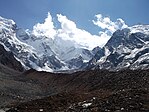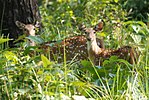Far-Western Development Region, Nepal
This article needs additional citations for verification. (July 2014) |
Far-Western Development Region
Sudur Pashchimānchal Bikās Kshetra | |
|---|---|
Former region | |
|
Clockwise from top NPT ) |
The Far-Western Development Region (
The Far-Western Region covered 19,539 square kilometers. It had nine districts with the regional headquarters at Dipayal,
It comprised two zones:
The region was sometimes called the
History
Raikas
Niranjan Malla Dev founded Doti Kingdom around the 13th century after the fall of
Niranjan Malla Dev (Founder of Doti Kingdom), Nagi Malla (1238), Ripu Malla (1279), Nirai Pal (1353 may be of Askot and historical evidence of him from 1354 AD has been found in Almoda), Nag Malla (1384), Dhir Malla (1400), Ripu Malla (1410), Anand Malla (1430), Balinarayan Malla (not known), Sansar Malla (1442), Kalyan Malla (1443), Suratan Malla (1478), Kriti Malla (1482), Prithivi Malla (1488), Medini Jay Malla (1512), Ashok Malla (1517), Raj Malla (1539), Arjun Malla/Sahi (not known but he was ruling Sira as Malla and Doti as Shahi), Bhupati Malla/Shahi (1558), Sagaram Shahi (1567), Hari Malla/Shahi (1581 Last Raikas King of Sira and adjoining part of Nepal), Rudra Shahi (1630), Vikram Shahi (1642), Mandhata Shahi (1671), Raghunath Shahi (1690), Hari Shahi (1720), Krishna Shahi (1760), Deep Shahi (1785), Prithivi pati Shahi (1790, 'he had fought against the Nepali Ruler (Gorkhali Ruler) with British in 1814 A.D').[4]
The historic place of war between the Doti Kingdom and Nepal (Gorkha kingdom) during the period of Gorkha Expansion in 1790, according to the history of Nepal, is Nari-Dang, on the bank of the Seti River. The Dumrakot was the base of Doti Kingdom for fighting against Gorkhali.
Mongol/Mughal invasion
During the period of Akbar, 16th century, Mongols (Mughals) attacked the Raikas. They invaded Ajemeru, capital of the Raikas Kingdom. Ajemeru is now in Dadeldhura District in the Far-Western region. According to Indo-Persian historian Abd-ul-Qadir Bada'uni (c. 1540 – 1615), Army Chief of Akbar, Khan, lured by the wealth and treasury of the Raikas state, attempted to plunder the state, but did not succeed.[5]
Major cities
Dhangadhi is a sub metropolitan city in Far-Western Nepal (Sudurpashchim Province) is located in Kailali District of Seti Zone.
Tikapur is another biggest city in the Far-Western region. It was popular for tourism and trade as it serves the best transit point for Nepal-India border in the Far-Western region.
Amargadhi was the headquarters of Dadeldhura District.
Akhand Sudurpaschim
Akhand Sudurpaschim (अखण्ड सुदूरपश्चिम) is a movement orchestrated by the natives of Far Western Region aiming to create a separate province and self-determination rights for the native population. Natives have claimed two districts of
References
- ^ "An Overview of the Far Western Region of Nepal | Nepal Information Platform". Un.org.np. 2011-05-20. Archived from the original on 2014-07-16. Retrieved 2015-06-04.
- OCLC 183008777.
- ^ "History of Dolpa". Topnepal.com. Retrieved 2015-06-04.
- ^ "Courthouse in Far-Western Region, Nepal". Mygola.com. Retrieved 2015-06-04.
- ^ "Kumaon History". Thekumaonhills.com. 1947-03-29. Archived from the original on 2020-02-19. Retrieved 2015-06-04.
External links
- Farwesternnepal.com
- Un.org.np Archived 2014-07-16 at the Wayback Machine
- Thegreathimalayatrail.org Archived 2014-07-22 at the Wayback Machine
- Farwesternnepal.org Archived 2019-07-28 at the Wayback Machine









